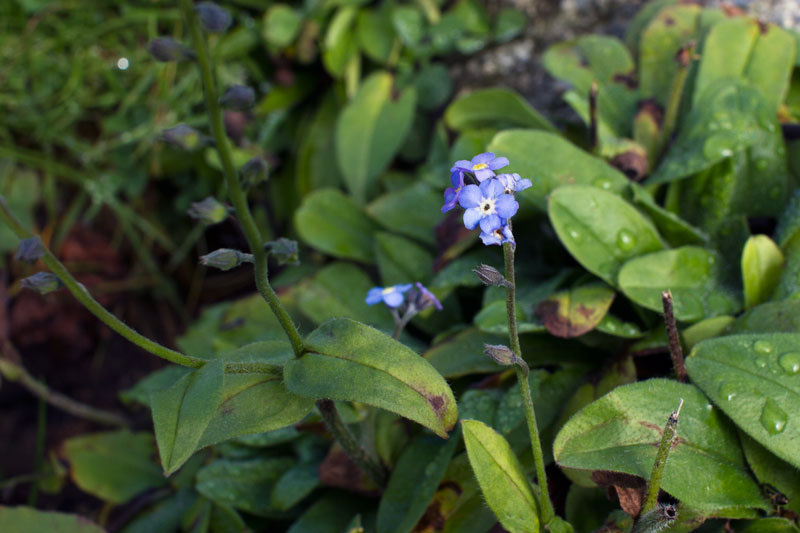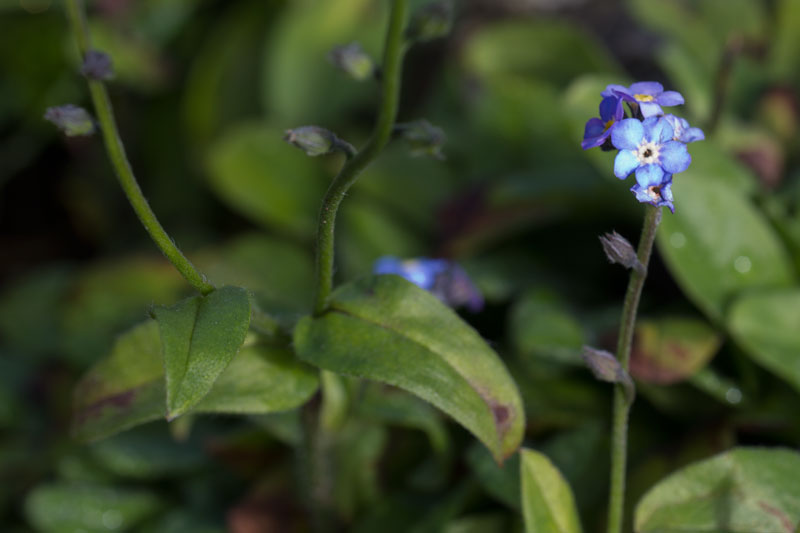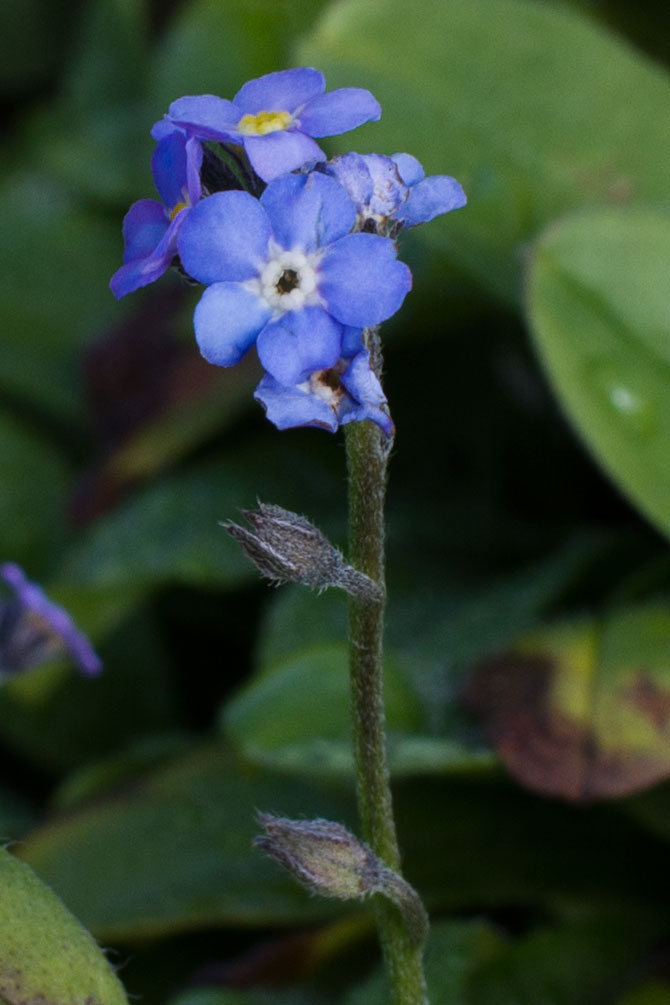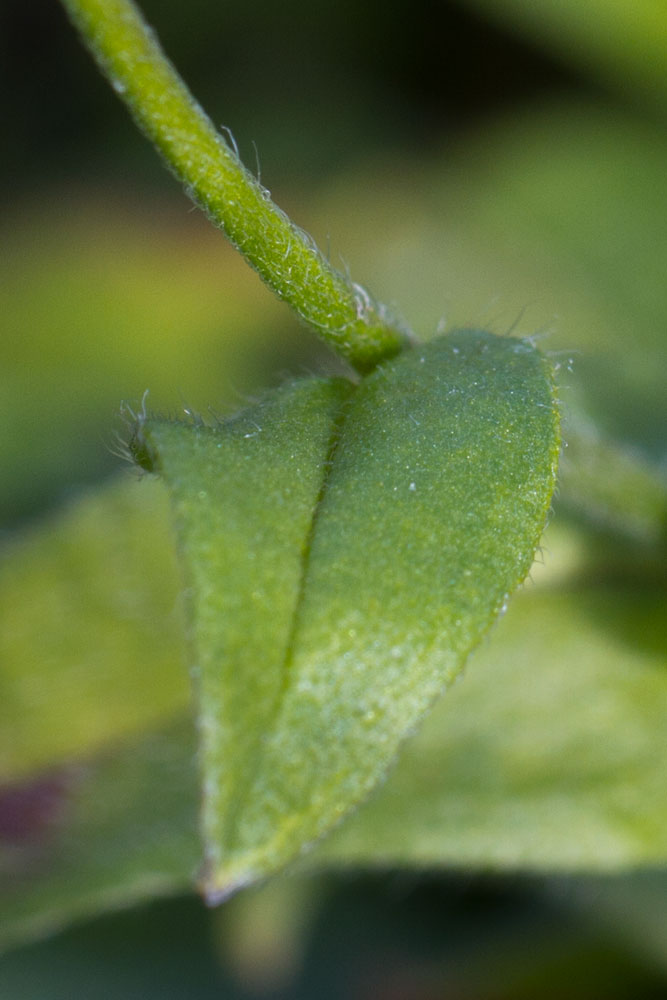Myosotis laxa subsp. caespitosa (Schultz) Hyl. ex Nordh., Norsk Fl. 529 1940. (Syn: Myosotis caespitosa Schultz; Myosotis caespitosa f. chino T.D. Magalashvili; Myosotis caespitosa var. neglecta Schust.; Myosotis commutata Roem. & Schult.; Myosotis laxa f. neglecta (R. Schust.) G.H. Loos; Myosotis lingulata Lehm.; Myosotis maritima Ledeb.; Myosotis nemorosa Bunge ex A. DC.; Myosotis palustris Benth.; Myosotis scorpioides subsp. caespitosa (Schultz) Herm.; Myosotis sparsiflora Kirschl. ex Mutel; Myosotis uliginosa Schrad.) as per The Plant List Ver.1.1 & Catalogue of Life; Boraginaceae for ID ABOCT2016/02 : 14 posts by 3 authors. 3 images. I have been meaning to share these photos taken on my walks to Ilaqa last month. As is clear in the first photo, the leaves are packed together and flowers appear on spikes. I am not sure if the photos are good enough to show all details. At first I had thought of it as a Trigonotis sp. but I am not sure. Please advise. Ilaqa, Above Triund, HP 3300m approx. 04 September 2016 Pl. check comparative images at Myosotis check in Boraginaceae for Decalepidanthus moltkioides I think this plant is the same as the other one in ABOCT2016/03. It definitely needs more evidence for a correct ID. My thanks to … No, both plants are different. Pl. Check again. No these images are not of the Decalepidanthus moltkioides which I knew as Pseudomertemsia moltkioides. These genera have corolla-tubes usually much longer than the calyx. I remember showing images of a lovely miniature version of the above species during lectures I gave about Kashmir to rock garden enthusiasts in the UK. This particular plant was then known as Pseudomertensia moltkioides var. primuloides – quite a mouthful. I joked with the audiences that I would be testing them with the names at the end! This plant is now Decalepidanthus primuloides. We all know that the Boraginaceae family has many similar genera which require close examination, sometimes ripe fruit to be certain. The synonymy of names complicates matters further. I shall comment further about Myosotis later – must depart to give a lecture on the Flowers of Kashmir. Further to my previous e-mail re: Myosotis. May I request As I have delved more deeply into this genus the more complicated it has become. May I request that everyone who is taking plant photos seriously should have with them a x10 (ideally x20) hand at all times (attached to a cord around one’s neck) – more advanced versions are now available. I do not know about availability of such hand lenses in India but I am sure some members of this group will be able to tell us and recommend good quality makes. With the aid of such a hand lens the hairs on the calyces of Myosotis can be noted. Gradually, each person who wishes to investigate complicated genera further will learn to recognise genera that need to be examined more closely and can undertake valuable field-work on future walks and treks by making notes of the characteristics they have learnt to look out for. It is clear that most members of the Boraginaceae family need to be look at closely – even if you are not certain when taking the photos which genus they belong to! Use of hand lenses will open up a new world to those who have not used them before – just as the close-up images taken with digital macro-lenses is showing members of this group much greater detail than was possible in the past. The more detail we can observe the better our understanding of each genus and species – leading to greater reliability and consistency of the identifications performed. I am thus investigating the Himalayan representatives of this difficult genus more thoroughly s can reach some meaningful conclusions. The evidence to-date suggests that this, like Clematis orientalis and related species is in a muddle – just as Clematis connata and related genera has led to over-recoding and misidentification of C.buchananiana. It is important to attempt to improve our understanding not just perpetuate the muddle. One thing one needs to do in such cases is explain one’s thinking as to on what basis a plant identification is made – rather than simply stating with confidence a species name or suggesting a possible identification, especially when one struggles to detect characteristic features from the photo(s) posted. I shall comment further as soon as can. And even if some disagree with my preliminary thinking (which it is) it opens up and stimulates discussion. One of the weaknesses of the on-line efloraofPakistan is that it is abbreviated (at least I think so). The early, printed versions of each Family Revision (which is based upon Stewart’s Annotated Catalogue of the Vascular Plants of Pakistan & Kashmir’ (if only such work like this existed for India) often provided detailed discussion and a list of locations and collection numbers of specimens for each species which had been inspected –allowing one to judge the geographic and often altitudinal range of each species. Like the ‘Concise’ version of ‘Flowers of the Himalaya’, invaluable information is lost. Have made a special effort to check out the species of Myosotis I have been mostly correcting entries, now the specimen from above Triund that started it all off! Yes, this does seem to fit Myosotis laxa subsp. caespitosa – the calyces appear to have appressed hairs (though there are no good close-ups) and the lobes are cut to more than half-way, so ruling out M.palustris – though the habitat is not as wet as one might expect. I have been reading your detailed emails packed with good advice and learning. I am guilty of some of the errors you warn against while identifying plants but I am slowly learning and make it a point to photograph necessary details when I know what they are. However, often, faced with a new plant, I do not have sufficient preliminary knowledge on the genus to immediately know which characteristics are necessary to positively identify the species. And I miss out, making it hard to identify the species. The plant in this post was photographed after coming down from an arduous walk to about 3500m and I recall having little motivation in bending down and getting close ups. I will need to do that again next year or sooner if the opportunity arises. I have cropped two photos to show the calyces and leaves a little closer for the time being. 2 images. I quite sympathise about what it feels like towards the end of an arduous day! I am keen, highly motivated and dedicated but reach ‘saturation’ point towards the end of particularly tough days, when I really am not the slightest bit interested in looking at another plant! It is encouraging that what I am sharing is being read and “taken on board”. We all progress and can learn from others. The best and most efficient way to learn is to pick up tips from experienced people. We were all started at the beginning and continue to have much to learn. I am 58 with about 45 years behind me taking a serious interest in identifying plants. Don’t expect I shall match Dr Ralph Stewart, the American botanist who lived to 102! After retiring as Principal of Gordon College, Rawalpindi he took up a post as Research Associate at the herbarium, University of Michigan at Ann Arbor, aged 70 – and did his best botanical work over the next 2 decades. He visited Ladakh back in 1912. It was an honour to meet him. Thanks, … Very interesting to read this. References: Flora of China (Myosotis caespitosa C. F. Schultz syn: Myosotis lingulata Lehmann; M. scorpioides Linnaeus subsp. caespitosa (C. F. Schultz) Hermann; M. uliginosa Schrader.) Tropicos Flora of Pakistan (Myosotis caespitosa C.F. Schultz Myosotis scorpioides subsp. caespitosa (Schultz) Hermann) Annotated checklist of Flowering plants of Nepal (Myosotis caespitosa Schultz) India Biodiversity Portal |
Myosotis laxa subsp. caespitosa
Updated on December 24, 2024





